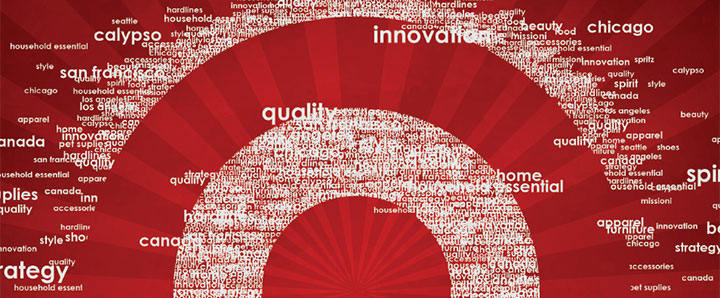In art theory, there are fundamental principles used by many different art forms. We all know about 'Harmony', the most common one. Whether in Architect, Painting, Music, Design, Sculpture, Film, Dance... Harmony applies to them all. Achieving the basic goal of Harmony is easy if you very conservatively REPEAT the same elements, like same colors and sizes on your visual arts. No one can deny it's not harmonious. The question is whether too much harmony or consistency can be unappealing and boring...
When repeating sound made with the same notes and silence, it's not music. It's noise.
When repeating the same colors and same sizes of graphic elements, it's not a piece of appealing visual design. It's a pattern. Rhythm makes the music notes go up and down, long and short. Rhythm makes music move and flow, then 'Harmony' is a final goal on top of the Rhythm. That's music creation. Similarly, in Visual Communication Arts, if we apply the principle of 'Rhythm' to Visual Communication Arts, it works perfectly.
'Your design sounds like this ****' I always sing in my class... My students laugh, but it works.Young college design students always have earphone on during studio class. They usually enjoy music more than their design work. For most people, music is an instinct. Listener can tell easily if it's a good song or just noise. But visual judgement requires talent and training. When they have difficulties understanding why their design should have variation and consistency (or harmony), I sing their design out. This may sound odd, but very helpful.
A couple of years ago, there was a printer radio commercial. The voiceover and music perfectly described the difference in the printer resolutions without visually seeing the actual printing results. This is the same concept!
When working on multiple page publication design, "Rhythm" is the key to success. Each page layout may look great by itself. But when putting them together in sequence, those individual pages turn into one giant piece. One giant piece needs to look as great as the standalone pages.
Percentage, scale, and proportion are great ways to measure the rhythm. Let's use the most visible design element of color, as an example. On a single page layout, if the color scheme is red, black and white, then let's look at the color proportions of these three colors. If red, black and white are equally proportioned into 1/3, 1/3, 1/3, then your design sounds like 'Do, Do, Do'. If Red is ?, White is 1/8 and Black is 5/8, then your design sounds like 'Mi, Do, So'. Which one sounds more like music?
Next, let's look at the sequence pages. Spread #1 - Red is 20%, Spread #2 - Red is 25%, and Spread 3 - Red is 22%. You may think they are different, but this slight difference is enough to bore the viewers, like putting the listener sleep with a boring movie or music. Meanwhile, if Spread #1 - Red is 20%, Spread - Red is 75%, and Spread #3- Red is 45%, this down-up-down creates rhythm, the movement of the design.
This applies not only to color, but also to line stroke, typography, shapes ... While variations create "rhythm", designers also need to balance Consistency and Harmony. The most common confusion that arises with young design students is that they think Consistency means similarities, but Rhythm means variations. They are opposite. How do you balance both? This is where Harmony plays an important role.
Using the same color example- Why should we set up one color scheme through one multi-page publication design? If Rhythm were just simple variation by using different colors for no reason, then each spread could possibly have completely different color tones. Spread #1 is dark green, Spread #2 is bright orange, Spread #3 is baby blue and pink... each page becomes a standalone with no Harmony, no consistency. It's not ONE book, you may think, but at least it has Rhythm. However, your design song sounds like it begins with classical music, suddenly changes to heavy metal, and ends with children's song.
If we consider Consistency when we look at color Rhythm, then we can easily get Harmony. Consistency of colors doesn't mean using one color again and again. For example, when working on Google's publication design, we could use its four colors through the whole book. Setting a consistent color theme by using certain colors is a good and easy way to go.
This is the same with the font. Rhythm doesn't mean you use several different typefaces. The easy way would be to use one font forever. But again, this is too consistent, too boring. So, we add Rhythm by using three fonts (A, B, C) instead of one font (A). We go from one Font with A's "A, A, A, A..." across all spreads to a more rhythmic variation like "A, AB, BC, AC, ABC, B, C..." on different spreads. It is now Rhythmic, but can we say it's not consistent? No. We maintain Consistency by having three consistent fonts (ABC), brought back across different spread. We now validate the "Consistency" rule.
Shapes are more difficult than color and font to produce rhythm. In most cases, if we use curvy shapes, we keep curvy through the entire publication. Or angles, circles, triangles, rectangles... We usually don't mix different shapes. But we do use proportions and positioning to create the Rhythm. For example: Rectangle shapes can be horizontal and vertical. We use different sizes and orientations to create variation.
When inserting images, putting them in BOXES is the most common thought. If we maintain rhythm by varying the size of BOXES, the page layout could be too BOXY. If we add some organic shapes that are objects without background, then we leave that too-consistent, BOXY nightmare.
If we can work all design elements harmoniously in rhythm, your page layout will sing beautifully for you!





